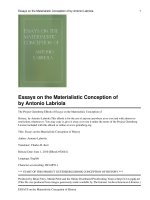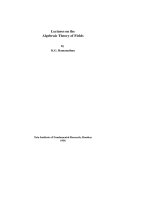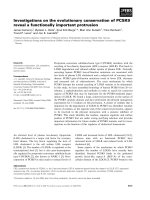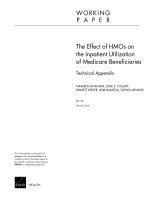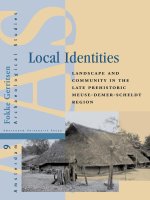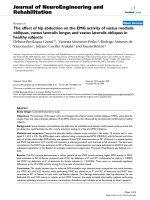Investigations on the antiplasmodial activity of ferrocenyl chalcones
Bạn đang xem bản rút gọn của tài liệu. Xem và tải ngay bản đầy đủ của tài liệu tại đây (1.72 MB, 179 trang )
INVESTIGATIONS ON THE ANTIPLASMODIAL
ACTIVITY OF FERROCENYL CHALCONES
WU XIANG
(B.Sc., Peking University)
A THESIS SUBMITTED
FOR THE DEGREE OF DOCTOR OF PHILOSOPHY
DEPARTMENT OF PHARMACY
NATIONAL UNIVERSITY OF SINGAPORE
2005
ACKNOWLEDGEMENTS
Above all, I would like to express my most sincere gratitude to my respected
supervisor Associate Professor Go Mei Lin for her constant encouragement, invaluable
advice and patient guidance throughout the course of my Ph.D. study.
I am deeply grateful to Dr. Prapon Wilairat, Dr. Oliver Kayser and Dr. Albrecht F.
Kiderlen for their tremendous generosity and hospitality in providing the key screening
facilities for this study.
I would also like to thank all my friends in Department of Pharmacy, National
University of Singapore, Department of Biochemistry, Mahidol University and
Department of Infectious Disease, Robert Koch Institute, especially Dr. Liu Mei, Ms.
Chua Hui Lee, Ms. Liu Xiao Ling for their friendship and support. Special thanks are
extended to Ms. Ng Sek Eng and Madam Oh Tang Booy for their precious assistance
during my research.
Finally, I would like to thank my parents and my brother. Nothing can express my
gratitude for their love, understanding and support.
i
TABLE OF CONTENTS
Acknowledgements i
Table of Contents ii
Summary vii
Publications and Presentations ix
Chapter 1 Introduction 1-21
1.1 Malaria 2
1.2 Transition Metal Complexes with Therapeutic Activity: Focus on Ferrocene-Based
Drugs 3
1.2.1 Ferrocene 5
1.2.2 Ferrocifens 8
1.2.3 Ferrochloroquine 10
1.2.4 Other ferrocenyl antiplasmodial agents 15
1.2.5 Cytotoxic ferrocenyl compounds 17
Chapter 2 Aim of Thesis 22-25
Chapter 3 Drug Design and Synthesis of Target Compounds 26-44
3.1 Introduction 27
3.2 Rationale of Drug Design 27
3.2.1 Ferrocenyl chalcones 27
3.2.2 Dihydroferrocenyl chalcones 32
3.2.3 Bis-substituted ferrocenyl chalcones 33
ii
3.3 Chemical Considerations 34
3.3.1 Synthesis of ferrocenyl chalcones 34
3.3.2 Synthesis of dihydroferrocenylchalcones 37
3.3.3 Synthesis of bis-substituted ferrocenyl chalcones 38
3.3.4 Characterization by proton NMR spectroscopy 39
3.4 Experimental methods 40
3.4.1 General experimental methods 40
3.4.2 Syntheses of ferrocenyl chalcones 41
3.4.3 Synthesis of dihydroferrocenyl chalcones 42
3.4.4 Synthesis of bis-substituted ferrocenylchalcones 43
3.5 Summary 43
Chapter 4 Investigation of The Anti-plasmodial Activities of Ferrocenyl
Chalcones 45-65
4.1 Introduction 46
4.2 Experimental Methods 47
4.2.1 Materials 47
4.2.2 In vitro evaluation of antiplasmodial activity using P. falciparum (K1) 48
4.2.3 In vivo evaluation of antimalarial activity against mice infected with P.
berghei (ANKA) 52
4.2.4 Evaluation of cytotoxic activity against MDCK and KB-3-1 cells 53
4.3 Results and Discussion 55
4.3.1 In vitro antiplasmodial activities of ferrocenyl chalcones 55
iii
4.3.2 Selectivity of antiplasmodial activity of ferrocenyl chalcones 66
4.3.3 In vivo antimalarial activities of ferrocenyl chalcones 66
4.4 Conclusion 67
Chapter 5 Quantitative Structure-Activity Relationships 69-97
5.1 Introduction 70
5.2 Experimental Methods 71
5.2.1 Materials 71
5.2.2 Determination of lipophilicity by reverse phase HPLC 72
5.2.3 Determination of the chemical shift of the carbonyl carbon 73
5.2.4 Determination of oxidation and reduction potentials by cyclic voltammetry
73
5.2.5 X- ray crystallography 74
5.2.6 Molecular modeling methods 74
5.2.7 Statistical methods 75
5.3 Results and Discussion 75
5.3.1 Lipophilicity 75
5.3.2 X-ray crystal structures of compounds 1, 12 and 28 76
5.3.3 Volume and surface areas 81
5.3.4 Electronic character of the carbonyl linkage in series A and B ferrocenyl
chalcones 81
5.3.5 Oxidizability of the ferrocene ring 86
iv
5.3.6 Correlation of the physicochemical properties and antiplasmodial activities of
ferrocenyl chalcones 88
5.4 Conclusion 97
Chapter 6 Investigations into The Mode of Antiplasmodial Activity of
Ferrocenyl Chalcones 98-133
6.1 Introduction 99
6.2 Investigations of The Heme Binding Properties of Ferrocenyl Chalcones 100
6.2.1 Experimental methods 103
6.2.1.1 General experimental methods and materials 103
6.2.1.2 Binding to heme 104
6.2.1.3 Inhibition of β-hematin formation 104
6.2.1.4 Inhibition of GSH mediated heme degradation 105
6.2.2 Results and discussion 109
6.2.2.1 Binding to heme 109
6.2.2.2 Inhibition of β-hematin formation 111
6.2.2.3 Inhibition of GSH mediated heme degradation 112
6.2.3 Conclusion 114
6.3 Effect of Ferrocenyl Chalcones on The Parasite-induced New Permeation Pathways
on The Erythrocyte 114
6.3.1 Experimental methods 115
6.3.2 Results and discussion 116
6.3.3 Conclusion 116
v
6.4 Oxidant Properties of Ferrocenyl Chalcones 117
6.4.1 Experimental methods 118
6.4.1.1 Materials 118
6.4.1.2 Scavenging of ABTS radical cation 118
6.4.1.3 Spin trapping measurements 119
6.4.2 Results and discussion 120
6.4.2.1 Scavenging of ABTS radical cation 120
6.4.2.2 Spin trapping measurements 124
6.4.2.3 Correlation between TEAC and spin trapping properties of ferrocenyl
chalcones 129
6.4.3 Conclusion 131
6.5 Summary 132
Chapter 7 Conclusion and Proposal for Future Work 134-139
References 140-156
Appendix I-XIX
Table 1 II-XIV
Table 2 XV-XVII
Table 3 XVIII
Table 4 XIX
vi
SUMMARY
A series of ferrocenyl chalcones, dihydroferrocenyl chalcones and bis-substituted
ferrocenyl chalcones were synthesized and their antiplasmodial activities were evaluated
by measuring the inhibition of [
3
H] hypoxanthine uptake into a chloroquine- resistant
isolate of Plasmodium falciparum (K1). The selective toxicities of the compounds were
evaluated by determining their cytotoxicities against mammalian cell lines (MDCK and
KB3-1). The following physicochemical properties of the ferrocenyl chalcones were
determined by experimental or in silico methods: lipophilicity, molecular surface area
and volume, oxidation and reduction potential of ferrocene ring, reduction potential of
carbonyl linkage,
13
C chemical shift of carbonyl carbon and charge difference of carbonyl
oxygen and carbon. After the physicochemical parameters of the compounds were
collected, a structure-activity relationship study was carried out with multivariate tools,
principal component analysis (PCA) and partial least squares projection to latent
structures (PLS). The mode of antiplasmodial action of ferrocenyl chalcones was
investigated by determining their binding affinity to heme, inhibition of β-hematin
formation, inhibition of GSH mediated heme degradation, effect on the parasite-induced
new permeation pathways on the erythrocyte, scavenging of ABTS radical cation and
free radical generation.
About 1/3
rd
of the ferrocenyl chalcones showed antiplasmodial activity with IC
50
values less than 20 µM. In general, better activity was observed for compounds with
ferrocene as ring A. The most active compounds were 1-(3’-pyridinyl)-3-ferrocenyl-2-
propen-1-one (6) and 1-ferrocenyl-3-(4’-nitrophenyl)-2-propen-1-one (28), with IC
50
vii
values of 4.5 µM and 5.1 µM respectively. These two compounds had selectivity indices
(against KB3-1 cells) of 8.63 and 36.7 respectively .
In the QSAR study, the location of ferrocene ring was found to influence
physiochemical characteristics of the compounds. Series A compounds were generally
less lipophilic, had ferrocene rings that were more resistant to oxidation and more
polarized carbonyl linkages. In the best QSAR model, oxidizability of ferrocene and the
polarity of the carbonyl linkage were identified as important parameters for
antiplasmodial activity.
In the mode of action studies, ferrocenyl chalcones demonstrated little effect on
binding affinity to heme, inhibition of β-hematin formation, inhibition of GSH mediated
heme degradation and the parasite-induced new permeation pathways on the erythrocyte.
On another hand, investigations on the scavenging of ABTS radical cation and free
radical generation showed that ferrocenyl chalcones could generate free radicals rapidly.
However, a robust correlation could not be established between the capacity of
compounds to generate free radicals and antiplasmodial activity. Thus, free radical
generation may be an important, but not the only factor accounting for the antiplasmodial
activity of ferrocenyl chalcones. The other physicochemical properties of the ferrocenyl
chalcones should be considered together with their oxidant potential.
In conclusion, the study has shown that ferrocenyl chalcones demonstrated
antimalarial activity in vitro. Ferrocene was found to markedly affect the
physicochemical properties of ferrocenyl chalcones and to influence antiplasmodial
activity of these compounds.
viii
PUBLICATIONS AND PRESENTATIONS
Publications
• Wu X, Wilairat P, Go ML. Antimalarial Activity of Ferrocenyl Chalcones.
Bioorganic & Medicinal Chemistry Letters 12 (2002) 2299-2302
• Wu X, Go ML. Chapter 10: The Use of Iron-Based Drugs in Medicine.
Metallotherapeutic Drugs & Metal-based Diagnostic Agents. Ed: Gielen M and
Tiekink E. Publisher: John Wiley (2005) pp.179-200
• Go ML, Wu X, Liu XL. Chalcones: An Update on Cytotoxic and
Chemoprotective Properties. Current Medicinal Chemistry. 12 (2005) 481-499
• Wu X, Khoo SB, Tiekink ERT, Kostetski I, Kocherginsky N, Tan ALC, Wilairat
P, Go ML. Antiplasmodial Activity of Ferrocenyl Chalcones: Investigations into
The Role of Ferrocene. European Journal of Pharmaceutical Sciences. 27 (2006)
175-187.
ix
Conference Presentations
•
•
Wu X, Wilairat P, Go ML. Antimalarial Activity of Ferrocenyl Chalcones.
American Association of Pharmaceutical Scientists (AAPS). Nov. 10-14, 2002,
Toronto, Canada.
•
•
Wu X, Go ML, Wilairat P, Kayser O, Kiderlen A. Antimalarial and
Antileishmanial Activity of Ferrocenyl Chalcones. Asian Association of Schools
of Pharmacy (AASP). Jun. 4-6, 2004, Beijing, China.
• Wu X., Go ML, Kayser O, Kilderlen AF. Antileishmanial Properties of
Ferrocenyl Chalcones. World Conference on Magic Bullets. Sep. 9-11, 2004,
Nurnberg, Germany.
x
1
CHAPTER ONE
INTRODUCTION
2
1.1 Malaria
Malaria is probably one of the oldest diseases to afflict mankind. Fossils of
the Anopheles mosquito, the insect vector of malaria, dating back to 30 million years,
have been uncovered, attesting to the ancient origins of the disease. Without a doubt,
malaria had a profound impact on the course of human history.
PP
1
PP
Yet, about fifty years
ago, the world faced the exciting prospect of eradicating malaria. The insecticide
1,1,1-trichloro-2,2-bis-(p-chlorophenyl) ethane (DDT) had succeeded in curbing the
proliferation of the Anopheles mosquito, the vector of Plasmodium, which is the
causative organism of malaria. Impressive therapeutic successes had been scored
with chloroquine – a cheap and highly efficacious antimalarial agent. Indeed, the
global dream of eradicating malaria appeared attainable when transmission of
endemic malaria in several European countries was achieved in the 1960s.
Unfortunately, the optimism was short-lived as both the Anopheles mosquito and
Plasmodium showed greater than anticipated staying power. The spread of drug
resistance and the environmental hazards associated with DDT meant that fewer
effective resources were available to combat malaria. It also highlighted the need to
address malaria as a global problem that goes beyond the boundaries of individual
nations.
In 1998, the Roll Back Malaria (RBM) Global Partnership was launched by
the World Health Organization (WHO), United Nations Children's Fund (UNICEF),
United Nations Development Programme (UNDP) and World Bank to provide a
coordinated international approach to confront malaria, with the goal of halving the
burden of malaria by 2010.
PP
2
PP
Five years later in 2005, it looked, on the face of things,
3
as though not a lot of progress had been made. About 500 million cases of malaria
are reported around the world every year, the vast majority in Africa. There is no
evidence that this had changed since 2000. In fact, some sources suggested that some
parts of the African continent had actually seen a resurgence of malaria.
PP
3
PP
This dismal
state of affairs has evoked strong criticism. An editorial in the Lancet, a leading
medical journal, charged that by not issuing strong technical advice to individual
countries, the RBM had indirectly contributed to the spread of drug resistance and the
steady deterioration of eradication efforts.
PP
4
PP
It concluded that the RBM may have
done “more harm than good.” The Economist newspaper concurred that while it was
true that the RBM had proven ineffective because of its unwieldy organizational
structure, the limited progress had more to do with the lack of effective ways to
address the disease, the absence of drugs to combat the spread of resistance and the
lack of monetary support.
PP
3
PP
These obstacles, however, are being tackled. The
deployment of bed nets impregnated with insecticides, the extraordinary effectiveness
of artemisinin, the supply of which is rising to match the demand, and major cash
injections from philanthropic organizations like the Gates Foundation, would make
the future brighter than critics might have predicted. Whether malaria would indeed
be rolled back over the next five years will depend on how effectively these resources
are deployed.
1.2 Transition Metal Complexes with Therapeutic Activity: Focus on Ferrocene-
Based Drugs
4
Interest in the therapeutic properties of metal complexes can be attributed to
several factors. Certainly, the serendipitous discovery of cisplatin, widely
acknowledged as a leading metal-based drug for the treatment of cancer, has
highlighted the potential usefulness of metal complexes in medicine. Metal based
drugs can form additional drug-receptors, thereby enhancing affinity, as the positively
charged metal center will be attracted to negatively charged biomolecules such as
nucleic acids and proteins, which are important components of endogenous receptors.
Not withstanding the benefits of metal-based drugs, their development as drugs has
not been easy.
PP
5
Abrams and MurrerPP
6
PP
noted that the field of medicinal inorganic chemistry as
one having “many important applications, but few principles tying the field together.”
Today, with more applications emerging, the need for core principles governing the
design of metal-based drugs is even more pressing. Thompson and Orvig
PP
7
PP
proposed
the following as key therapeutic principles, namely (i) the significance of the dose, (ii)
the realization that it is the entire chemical entity, and not just the metal ion that
determines the therapeutic effect, and (iii) the bioavailability of the metal-based
compound which will determine its relative biochemical impact.
“The right dose differentiates a poison and a remedy” highlights a particularly
relevant principle when dealing with metal based drugs. The toxicity of these
compounds due to the accumulation of metal ions in the body is of particular concern.
Thus, the pharmacokinetic profile of the metal complex must be investigated in great
detail, and favorable pharmacological outcomes must be convincingly demonstrated
in vivo with animal models before proceeding further. A mechanistic understanding
5
of how the metal complexes achieve their activities would be desirable as it will
provide a rational basis for the development of future candidates.
More so than other metals, metallic iron has long been associated with human
health. Natural springs rich in iron deposits (“chalybeate” waters) were widely
sought for their healing properties, thus establishing the reputations of Bath in
England, Spa in Belgium and Llandrindod Wells in Wales. Today, numerous
inorganic iron salts are used for the treatment of iron deficiency.
PP
8
PP
In contrast,
organoiron chemistry has been dominated by a single compound – ferrocene.
1.2.1 Ferrocene
Ferrocene or di(η
PP
5
PP
-cyclopentadienyl) iron(II) was accidentally discovered by
Peter L. Pauson and his graduate student Tom Kealy in 1951 when they attempted the
reductive coupling of the Grignard reagent cyclopentadienyl magnesium bromide in
the presence of ferric chloride.
PP
125
PP
As recounted by Pauson in 2001, “ a few drops of
the yellow solution …. evaporated, leaving yellow crystals. Could we have made a
yellow hydrocarbon, perhaps even the desired fulvalene? It seemed too good to be
true.”
PP
125
PP
It turned out that Paulson and Kealy did not synthesize fulvalene, whose
aromatic character was hotly debated at that time. Instead they had obtained an even
more novel addition to the class of non-benzenoid aromatics, a substance that was
subsequently named ferrocene, with an “–ene” ending to emphasize its aromatic
character.
Ferrocene comprises a ferrous ion (Fe
PP
2+
PP
) coordinated to two cyclopentadienyl
(Cp) rings. The d orbitals on Fe
PP
2+
PP
are coordinated into the π orbitals on the two
6
cyclopentadienyl radicals to form a unique sandwich structure first predicted by
infrared and nuclear magnetic resonance spectroscopies and later confirmed by X-ray
crystallography in 1954.
PP
125
PP
The prevailing belief was that bonds between transition
metals and hydrocarbon groups were unstable, since all recorded attempts to form
such linkages had failed. Ferrocene proved to be a notable exception. Not only was
the compound isolable, but it was stable to high temperatures and unaffected by water,
strong acids and alkalis. The first Fe-Cp dissociation energy in the gas phase was
found to be 380 kJ/mol in the gas phase.
PP
10
PP
The unique stability of ferrocene is
attributed to the distribution of 18 π electrons in the e
BB
2g
BB and a BB
1g
BB non bonding
molecular orbitals. Not withstanding its unique stability, ferrocene behaves like an
aromatic compound. It is susceptible to direct electrophilic substitution reactions,
giving rise to a variety of substituted ferrocenes.
Compared to other metallocenes, ferrocene is more widely employed in drug
design. This is prompted by several factors, foremost of which is the reputation of
ferrocene as a “safe” metallocene. Acute and chronic tests of ferrocene and several of
its derivatives attested to the relative safety of these compounds in many mammalian
species (dogs, rats, mice, monkeys).
PP
11, 12, 13
PP
Despite this reassuring data, the extent to
which iron is released from ferrocene-containing compounds during metabolism is
still not known. Ferrous iron can catalyze free radical reactions, leading to lipid
peroxidation of cellular membranes and the formation of reactive oxygen species
(ROS) via the Fenton reaction.
PP
14
PP
Some investigations suggested that the metal ion
(Fe
PP
2+
PP
) in ferrocene was not readily removed,PP
15, 16
PP
or if it was, the ion was quickly
7
incorporated into the iron-protein storage complex ferritin and processed by the body
in the same way as dietary iron, thus minimizing its harmful potential.PP
16, 17, 18
Medicinal chemists are also open to the inclusion of ferrocene into their drug
design strategies because of the novelty introduced by its presence. Ferrocene is
widely regarded as a substitute for the aromatic benzene ring. Ferrocene is aromatic
but more electron donating than benzene (σ
BB
para ferrocene
BB= - 0.18, σBB
para benzene
BB=0.01).PP
19
PP
In
terms of shape, ferrocene is as “wide” as benzene but substantially “thicker”. It is
also more lipophilic than benzene (π
BB
ferrocene
BB=2.46, πBB
benzene
BB=1.96)PP
19
PP
and its inclusion
into a molecule can be expected to influence membrane permeability and drug-like
character to good advantage. Since inappropriate pharmacokinetics is one of the
main reasons why lead compounds fail to transform into effective drugs,
PP
20
PP
the
potential usefulness of ferrocene in this regard has been recognized by medicinal
chemists.
There are many examples in the literature citing the use of ferrocene in drug
design strategies. In one study on some non-steroidal anti-inflammatory agents, the
replacement of the aromatic ring by ferrocene did not improve anti-arthritic or platelet
aggregatory activities in the resulting compounds.
PP
21
PP
The authors concluded that
ferrocene was not an appropriate bioisostere of the phenyl or pyrrole ring.
Investigations with ferrocene-containing penicillins, cephalosporins and rifamycins
showed that the inclusion of ferrocene did not confer any special advantage.
PP
22, 23
PP
On
the other hand, significant changes in activity profiles had been recorded when
ferrocene was introduced into established drugs like tamoxifen and chloroquine.
These are discussed in the following paragraphs.
8
1.2.2 Ferrocifens
Tamoxifen is an example of a selective estrogen receptor modulator (SERM),
which are compounds with tissue-selective estrogenic activities. The pharmacological
goal of these drugs is to produce estrogenic actions in those tissues where such effects
are beneficial (such as bone, brain, liver during postmenopausal hormone replacement)
and to have either no activity or an antagonistic effect in tissues such as breast and
endometrium, where estrogenic actions might be undesirable.
PP
24
PP
Tamoxifen is widely
used for the treatment of breast cancer but has limited efficacy for several reasons.
For one, its activity is restricted to estrogen receptor positive (ER+) tumours which
occur in approximately 60% of breast cancer cases. Treatment efficacy with
tamoxifen decreases with time due to the acquisition of drug resistance by the
tumours. Ferrocifens - compounds derived from the replacement of one of the phenyl
rings of tamoxifen with ferrocene, was one of the approaches made to improve the
therapeutic profile of tamoxifen.
O
Fe
O
N
N
Tamoxifen 1
In a ferrocifen, of which compound 1 is a typical example, the presence of the
triphenylethylene-like framework of tamoxifen ensured that recognition for the
estradiol receptor is retained. The addition of ferrocene introduced an oxidizing /
reducing genotoxic aspect that was absent in tamoxifen. It was hypothesized that
9
ferrocene could induce damage to DNA because the ferrous ion was oxidized to a
ferricenium-type radical ion that could either cleave DNA directly by associating with
it, or induced the formation of reactive oxygen species that were responsible for
genotoxicity. Several investigations lend support to this hypothesis, which will be
discussed in a latter section.
In a related approach, the grafting of ferrocene to organic diphenol structures
related to resveratrol and diethylstilbesterol which were compounds known to
recognize the estrogen receptor, provided further confirmation of the important
modulatory influence of ferrocene.
PP
25
PP
In this investigation, the ferrocenyl diphenol 2
inhibited the growth of both hormone dependent (ER+) and hormone independent
(ER-) breast cancer cell lines. Replacing ferrocene with phenyl to give the diphenol 3
resulted in a loss of the antiproliferative effect against both cell lines. Interestingly,
compound 4 which was isomeric with 2 had only a modest antiproliferative activity
against ER- cells and a weak proliferative effect on ER+ cells. These results showed
that the presence of ferrocene was a necessary but not sufficient prerequisite for
antiproliferative activity. The contrasting properties of compounds 2 and 4 suggested
that the position of the oxidizable ferrocenyl group was an important factor for
consideration.
Fe
OH
OH
OH
OH
Fe
OH
HO
2 3 4
10
1.2.3 Ferroquine
Ferroquine, also known as “ferrochloroquine” or “ferrocenyl chloroquine”,
was synthesized and evaluated for antiplasmodial activity by Biot and co-workers in
1997.
PP
8
PP
Ferrocene was inserted in place of two methylene groups in the butyl side
chain of chloroquine and the terminal amino group was varied to include several
basic functionalities. The most promising compound was the dimethyl analogue
(ferrochloroquine) which was 22 times more active than chloroquine against a
resistant strain in vitro, and as active as chloroquine against a susceptible strain.
N
HN
Cl
N
Fe
NCl
HN
NEt
2
Ferrochloroquine Chloroquine
Fe
NCl
HN
NCl
HN
N
H
Fe
2 C
4
H
5
O
6
H
N
H
2 C
4
H
5
O
6
5 6
Subsequent structure-activity studies showed that ferrocene itself had no
antimalarial activity and that the ferrocene-chloroquine combination was effective
only when ferrocene was covalently bonded to chloroquine.
PP
26
PP
The enantiomers of
ferrochloroquine showed equivalent antiplasmodial activity in vitro but were less
11
active than the racemate in vivo.PP
27
PP
The attachment of ferrocene to other positions of
chloroquine (compounds 5 and 6) proved to be detrimental.PP
28
PP
These findings
suggested that ferrocene was optimally located in ferrochloroquine.
It was anticipated that N-dealkylation of the terminal amino function of
ferrochloroquine would be an important metabolic pathway of the drug.
PP
26
PP
The
resulting dealkylated metabolites might be more active than ferrochloroquine, if the
analogy to chloroquine held true. This led to the syntheses of the desmethyl and
didesmethyl analogues of ferrochloroquine, but unlike the metabolites of chloroquine,
their in vitro activities were found to be similar to ferrochloroquine.
PP
26
NMe
2
N
HN
Cl
Fe
7
N
HN
Cl
NH
NMe
2
N
HN
Cl
NH
NMe
2
1
2
3
4
Fe
Fe
8 9
In ferrochloroquine, the quinoline ring and the terminal basic side chain were
attached to the same cyclopentadienyl ring of ferrocene, i.e. the substitution pattern
was 1,2. Beagley and co-workers investigated the effect of attaching the substituents
to different cyclopentadienyl rings, namely, to explore the effect of a 1,1’-substitution
pattern as shown in 7. Compound 7
PP
29
PP
was equipotent with ferrochloroquine against
chloroquine sensitive organisms but showed greater potency against resistant strains.
However, in another pair of 1,2 and 1,1’ ferrocenyl analogues (compounds 8 and 9), a
12
different profile was noted. Without more examples, it was difficult to comment
further on the relative importance of the 1,2 versus 1,1’ substitution pattern on
ferrocene. However, some differences would be expected. In 1,2-substitution, one of
the cyclopentadienyl rings of ferrocene was unsubstituted and X-ray crystallography
showed that the orientation of this ring made it almost parallel to quinoline. This
might enhance binding to potential receptors like heme, if the latter was an important
target for ferrochloroquine.
NCl
HN
Fe
HN
(CH
2
)
n
NCl
HN
Fe
N
NH
O
(CH
2
)
n
N
N
10: n=3 14: n=3
11: n=4 15: n=4
12: n=5 16: n=5
13: n=6 17: n=6
In another study, the methylene chain connecting N2 and N3 in 8 was varied
from n = 2 to n = 3, 4, 5 or 6 (10, 11, 12, 13). N3 was also modified to a urea moiety
to give another series of compounds (14, 15, 16, 17).
PP
30
PP
Some interesting observations
were made for the two series. Better activity was found for the urea analogues
against sensitive strains of plasmodia (P. falciparum D10), but not against resistant
strains where comparable activities were observed for the two series. Extending the
methylene side chain caused a fall in antiplasmodial activity of the ureas but not for
the non-ureas 10-13. Both series showed a progressive decrease in the half-wave
potential of the ferrocene analogues as the methylene chain was extended from n = 2
13
to n = 4. The half wave potential measures the ease with which FePP
2+
PP
in ferrocene
loses an electron, that is, undergoes oxidation to FePP
3+
PP
. The results indicated that the
urea analogue with the shorter methylene chain had a higher half-wave potential and
also greater antiplasmodial activity. The significance of this observation remains to
be fully explored but it may signal a role for the oxidizability of Fe
PP
2+
PP
in ferrocene for
antiplasmodial activity. In contrast, Beagley and co-workers
PP
29
PP
found equivalent
activity for ferrochloroquine and its phenyl analogue 18 and concluded that the
primary role of ferrocene was that of a hydrophobic spacer.
NCl
HN
N
18
The original hypothesis that led to the design of ferrochloroquine was that
since the Plasmodium had a strong affinity for free iron, an effective way of reducing
chloroquine resistance of the parasites would be to introduce iron to a chloroquine
molecule.
PP
9
PP
FePP
2+
PP
in ferrocene would in effect act as a “bait” to promote uptake and
accumulation of the drug within the food vacuole of the parasite. While
ferrochloroquine was indeed found to be more effective than chloroquine against
resistant organisms, the contribution of ferrocene to activity remained an open
question. Biot and co-workers provided one of the few detailed investigations into
the mechanism of action of ferrochloroquine.
PP
31
14
According to their proposal, the quinoline ring of ferrochloroquine
participated in a π-π stacking interaction with heme, thus preventing its aggregation
to form hemozoin. They showed that ferrochloroquine formed complexes with heme
in solution, and inhibited β-hematin formation. Therefore, both chloroquine and
ferrochloroquine may share the same drug target (heme) in plasmodia. What then
was the role of the ferrocenyl side chain in ferrochloroquine? The authors proposed
that the side chain caused a reduction in affinity of the molecule for the postulated
transporter linked to chloroquine resistance, P. falciparum chloroquine resistance
transporter (PfCRT) which served to efflux chloroquine from the food vacuole.
Several physicochemical characteristics of ferrochloroquine accounted for this unique
property. Firstly, the inclusion of ferrocene increased lipophilicity. The greater
lipophilicity of ferrochloroquine allowed it to block the PfCRT pore, much like a
resistance-reversing agent (for example, verapamil). Secondly, the pKa values of
ferrochloroquine (pKa
BB
1
BB = 8.19, pKaBB
2
BB = 6.99) were lower than that of chloroquine
(pKaBB
1
BB = 10.03, pKaBB
2
BB= 7.94).PP
32
PP
The crystal structure of neutral ferrochloroquine
showed a strong intramolecular hydrogen bond between the anilino nitrogen and the
tertiary dimethylamino function. This served to lower the pKa of the side chain
nitrogen atom as well as to reduce the N-N distance of the side chain. These
characteristics (greater lipophilicity, shorter N-N distance, lower basicity) of
ferrochloroquine may endow it with a poorer affinity for the chloroquine transporter
PfCRT. Thus, more ferrochloroquine was retained within the food vacuole, where it
could presumably interact with its target, resulting in greater activity against resistant
plasmodia.


